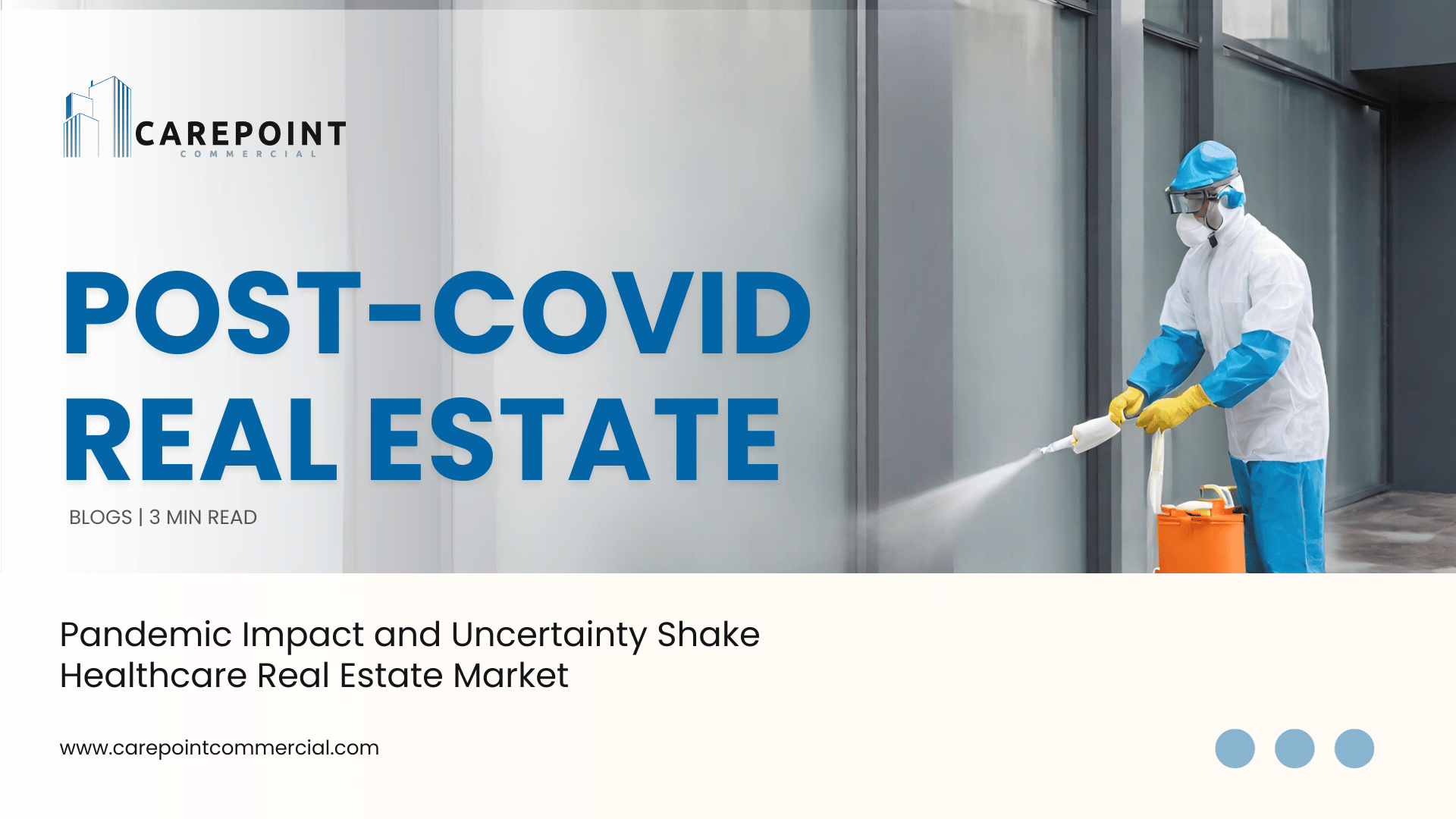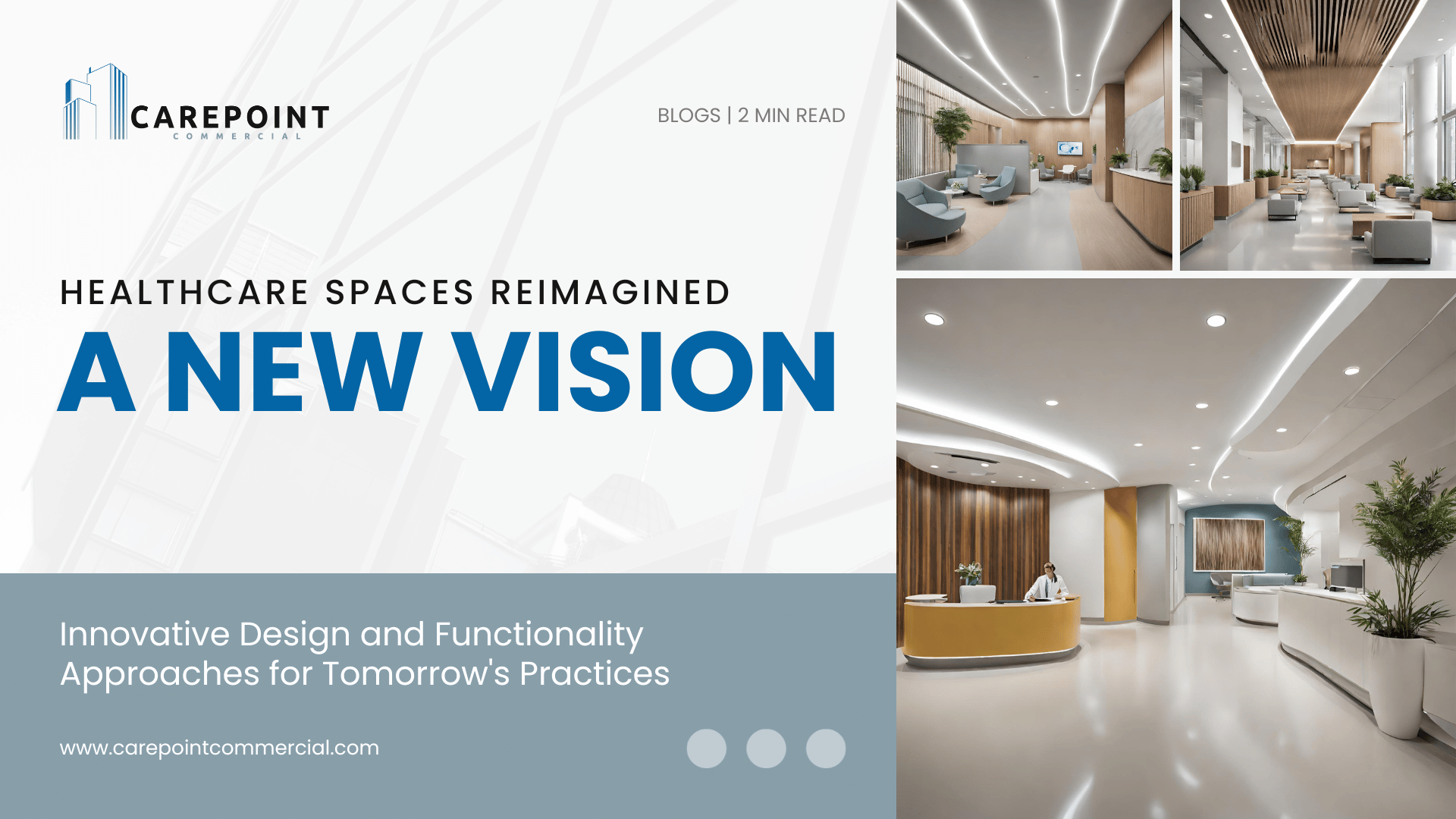Healthcare Spaces Reimagined: Innovative Design and Functionality Approaches for Tomorrow's Practices
The healthcare landscape is evolving rapidly, driven by advancements in technology, changing patient expectations, and a growing emphasis on...
3 min read
![]() CarePoint Commercial Marketing
:
Oct 2, 2023 6:14:00 PM
CarePoint Commercial Marketing
:
Oct 2, 2023 6:14:00 PM

As the global pandemic continues to unsettle the commercial real estate landscape, the healthcare sector grapples with escalating challenges and uncertainty.
This analytical piece scrutinizes the current market complexities, forecasts from industry leaders, and the future outlook.
It delves into financing aspects, development, design, and the role of real estate in addressing healthcare inequity, shedding light on the potential winners and losers in this volatile environment.
In the face of unprecedented challenges, the healthcare real estate market grapples with the effects of the COVID-19 pandemic. These effects include increased operating costs, labor and supply shortages, and the uncertainty brought about by rapid fluctuations in interest rates.
This has resulted in a significant impact on profitability, pushing organizations to reassess their financial strategies. The recovery timeline remains uncertain, heavily contingent on the management of the pandemic and the stabilization of the global economy.
Despite the daunting outlook, industry leaders remain optimistic, asserting that with adaptation and innovation, the market will navigate its way through these challenges. However, the lingering question remains: How long will it take for the healthcare real estate market to recover, and what will the new normal look like?
Drawing from the market adversity, industry pioneers like Murray Wolf and Jarrod Daddis offer insightful perspectives on the turbulent healthcare real estate landscape, its potential recovery timeline, and the transformative strategies needed to adapt successfully.
They analyze market trends, pinpointing the increasing operating costs and aging population as key challenges. Wolf and Daddis predict a possible market stabilization by 2025, despite the pandemic-induced uncertainty. Industry insights reveal a universal cost pressure and inadequate reimbursements, further complicating market conditions.
However, both pioneers emphasize on adaptability and innovation as crucial for navigating the current landscape. They advocate for a comprehensive understanding of user needs and robust teamwork as essential elements for success in this evolving sector.
How does the current state of the healthcare real estate sector reflect these challenges, and what does the future hold amidst this uncertainty?
The healthcare real estate market is grappling with the aftermath of the pandemic, evidenced by a slowdown in capital investment. Market recovery is a major concern, with uncertainty shaking investor confidence. However, the future outlook is not entirely bleak.
As the healthcare sector adapts to the new normal, strategies focusing on cost optimization and location intelligence are emerging. The aging population, coupled with an increased demand for healthcare services, is expected to drive capital investment.
Although the future is riddled with uncertainty, industry stakeholders are optimistic about a market recovery by 2025. This resilience amidst adversity underlines the sector’s potential for growth and evolution.
The dynamics of financing in the healthcare real estate sector have been significantly impacted by the pandemic, leading to a climate of uncertainty and market confusion. The rapid rise in interest rates has stoked fears of a slowdown in investment activities, further exacerbated by contraction from traditional sources of capital like banks and private equity firms.
This has induced a marked shift in how healthcare real estate projects are financed, with more reliance on innovative financing structures and less conventional sources of capital. Amidst these changes, the market is witnessing a polarizing effect with clear winners and losers emerging.
The ultimate outcome of these market shifts remains to be seen, but it is clear that the pandemic has fundamentally altered the landscape of financing in healthcare real estate.
Despite prevailing market uncertainties, a significant number of healthcare real estate deals are still being executed, albeit with longer timelines and increased diligence. The execution challenges are exacerbated by market volatility, making transactions more complex and demanding.
Investors are adopting more comprehensive risk assessments and due diligence processes, aiming to mitigate the potential impacts of volatility. Key factors affecting deal execution include the unpredictability of the pandemic’s trajectory, shifts in healthcare service delivery, and evolving patient behaviors.
Although these factors complicate deal execution, they also offer opportunities for strategic investments in the sector. As the market navigates this uncertainty, the resilience and adaptability demonstrated by stakeholders underline the sector’s potential for sustained growth, even in challenging conditions.
The pandemic’s impact on the healthcare real estate market is profound, inducing uncertainty and escalating costs. Despite this, industry pioneers predict recovery by 2025, underlining the importance of adapting to user needs and promoting teamwork.
As interest rates rise and traditional funding sources contract, innovative financing strategies are required. Addressing healthcare inequity through real estate, coupled with sensible development, design, and construction, could pave the way for a resilient market in the future.

The healthcare landscape is evolving rapidly, driven by advancements in technology, changing patient expectations, and a growing emphasis on...

The Triple Net Lease is a foundational component in commercial real estate, especially for healthcare professionals seeking the right space for their...

In commercial real estate, understanding the nuances of different lease types is crucial for shaping a business's budgeting and operational...